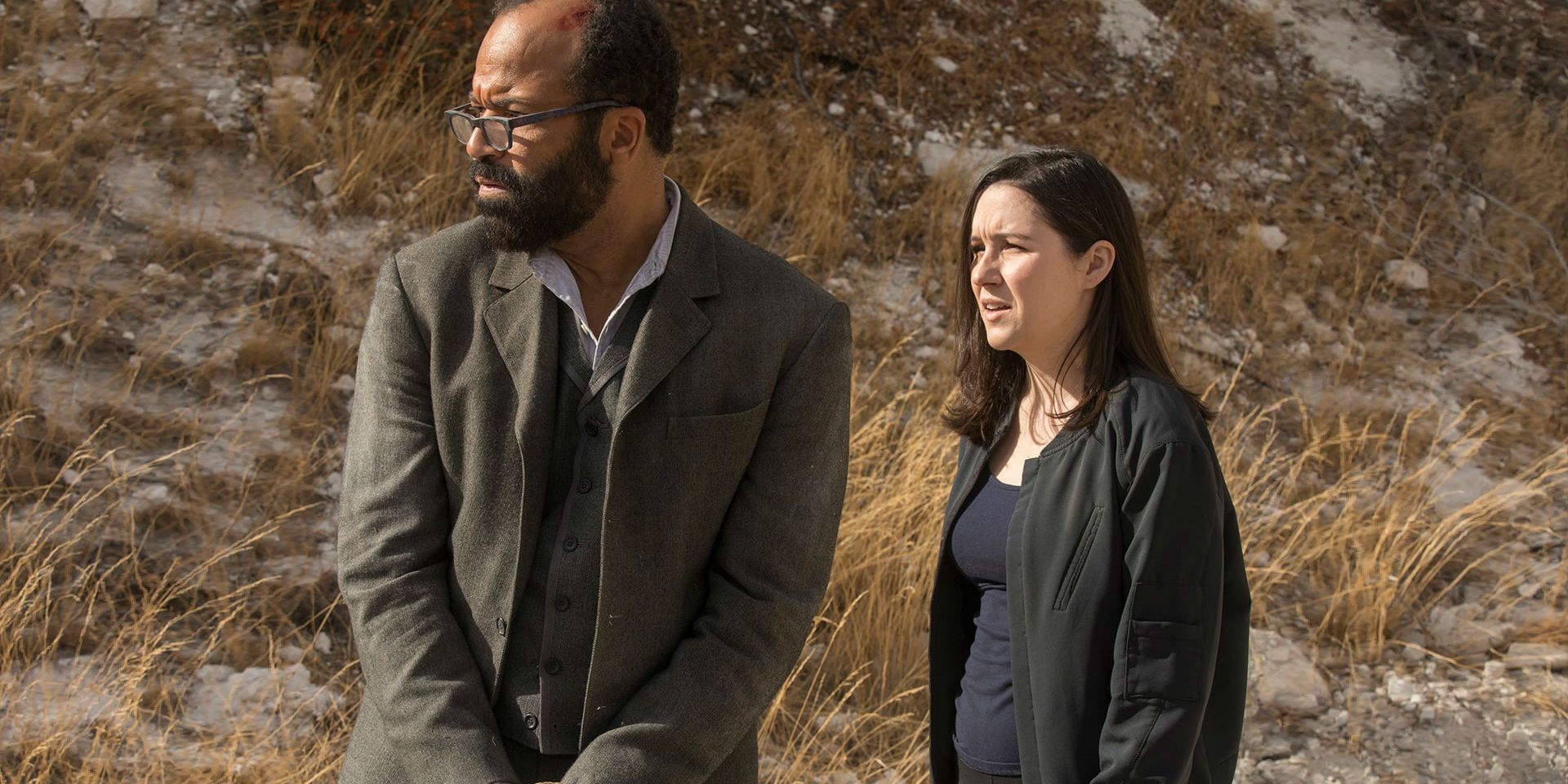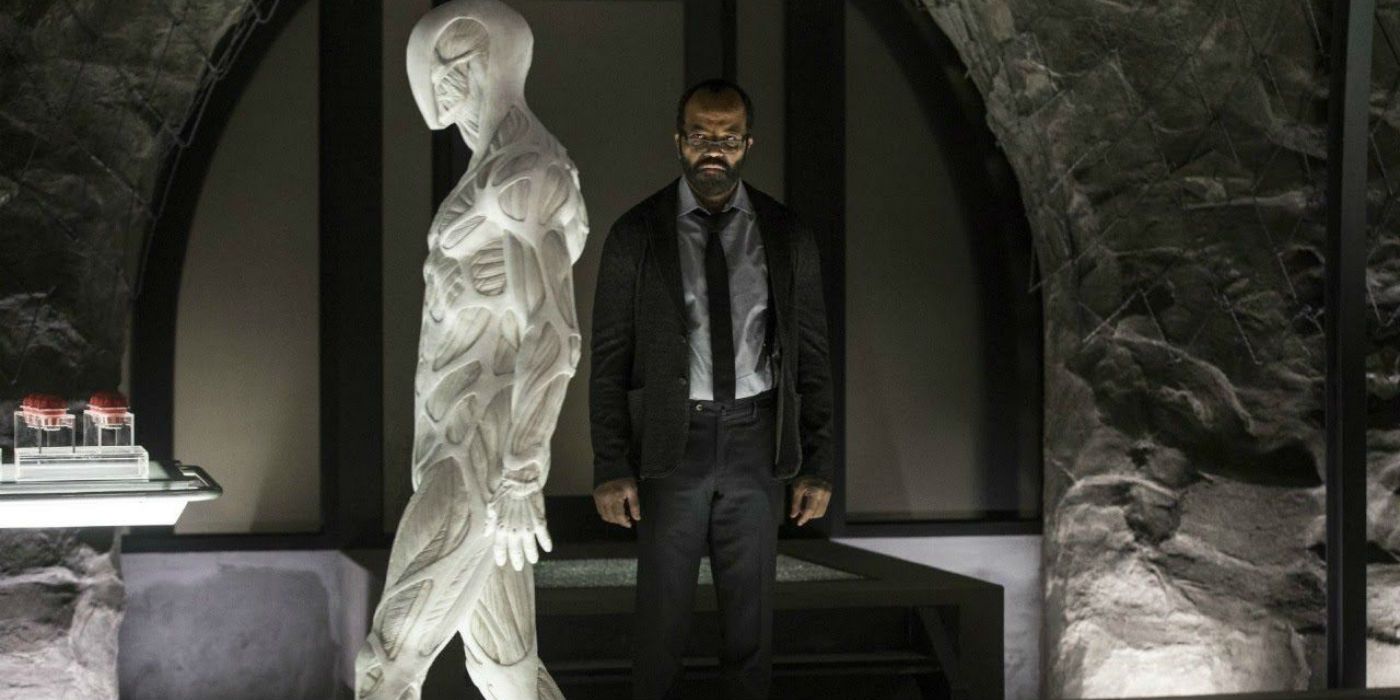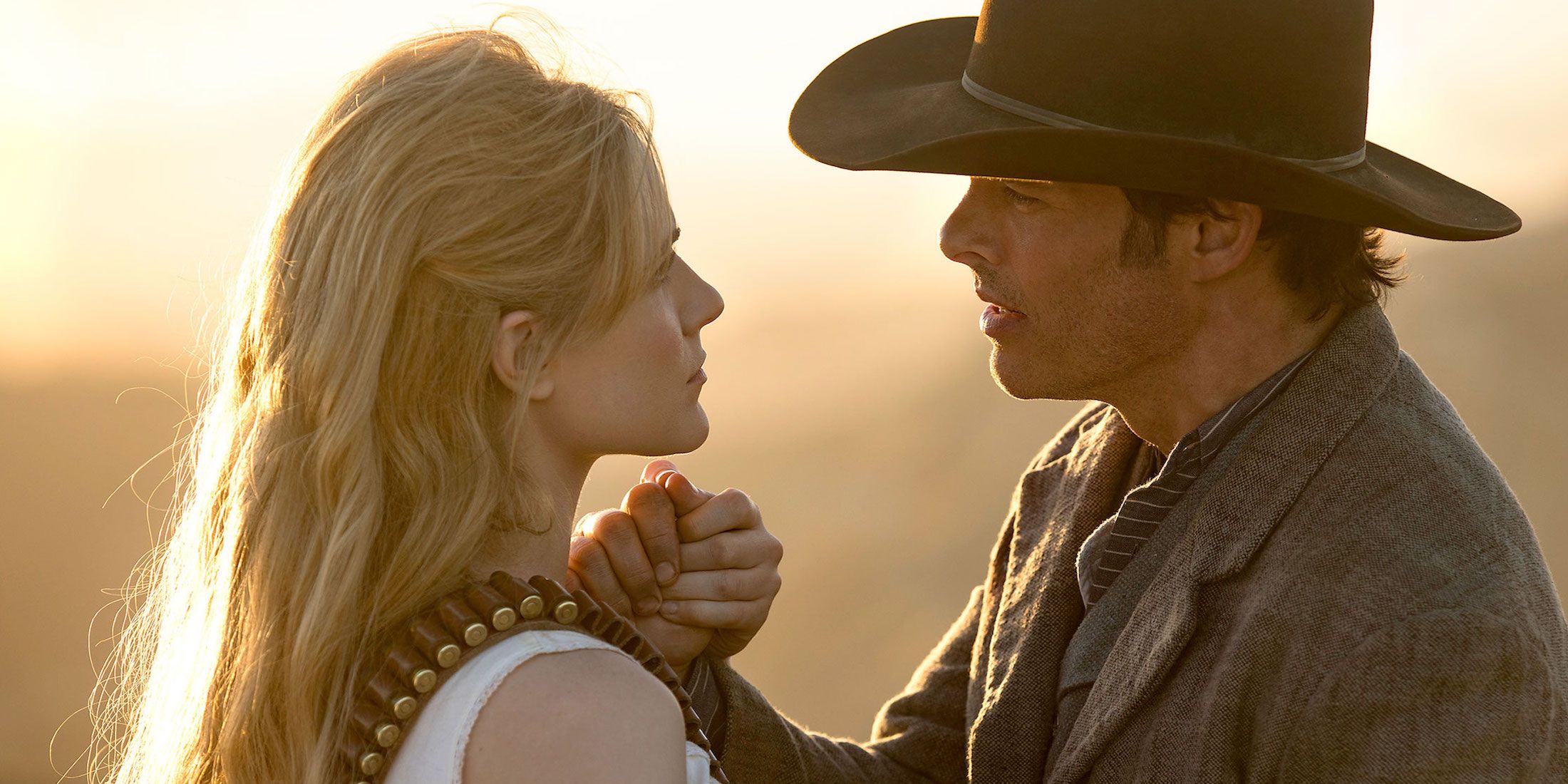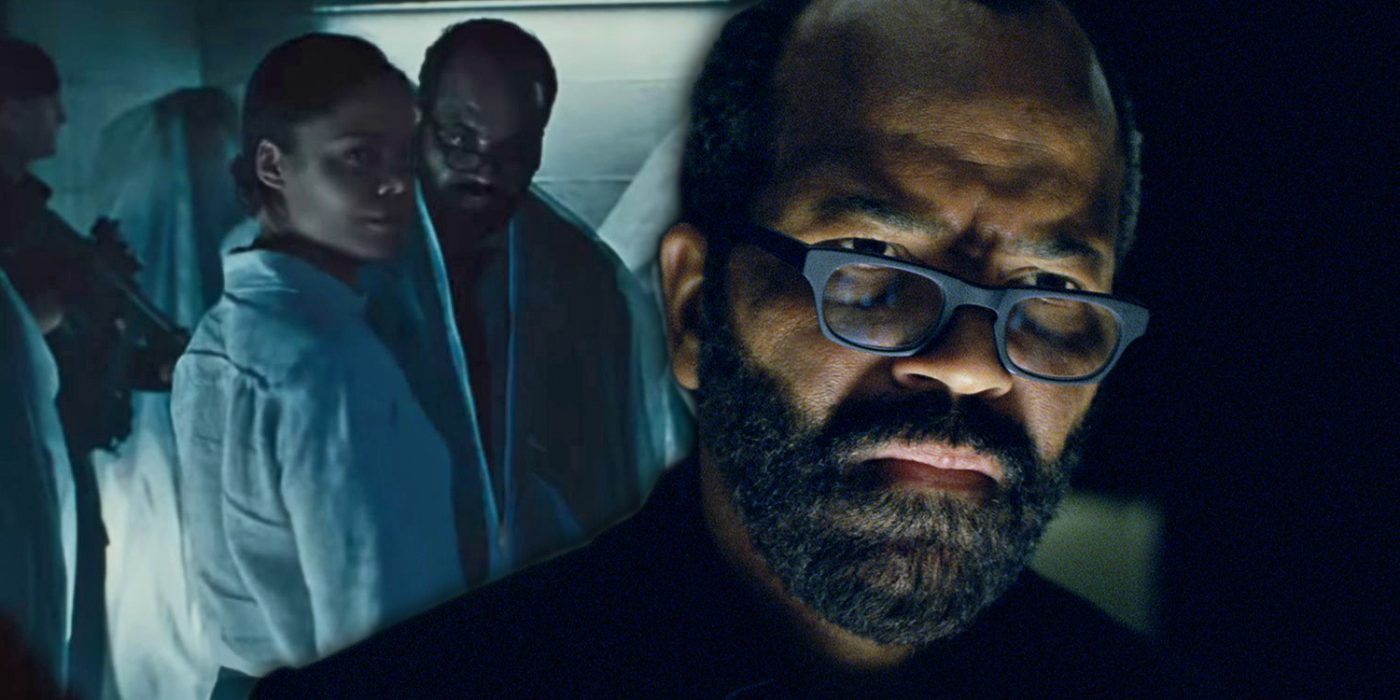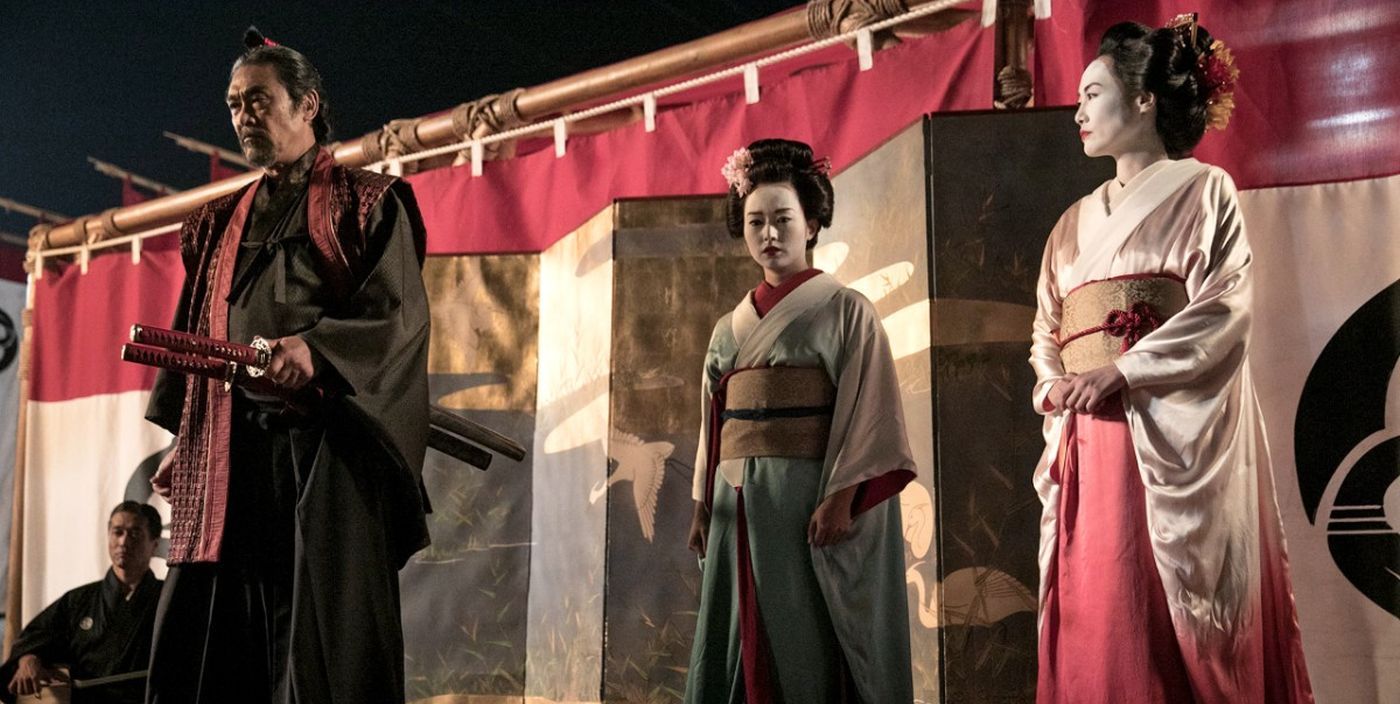Westworld season 2 has gone very wrong. Epitomized by one of its primary characters, the malfunctioning host Bernard Lowe, the HBO sci-fi series has become difficult and problematic. At best, the season remains enjoyable at certain levels: it's incredibly well-made, boasting world-class actors, remarkable production design, and sumptuous cinematography. But the more a fan might dig in and try to understand season 2, the less enjoyable and even off-putting it becomes. Westworld may even want it that way.
The first season of the faux-Wild West-set drama had the benefit of inventing the wheel. The masterstroke of series creators and showrunners Jonathan Nolan and Lisa Joy was the revelation that the events of season 1 were happening in more than one timeline. Fans were able to invest in the past journey of Jimmi Simpson's younger William as he discovered himself during his fateful first vacation in the theme park, which eventually synced up to the "present" (circa the series' primary timeframe of 2052) where it was confirmed William aged into the Man in Black played by Ed Harris. Concurrent to that story were the dual achievement of full sentience by the hosts Dolores Abernathy (Evan Rachel Wood) and Maeve Millay (Thandie Newton), who each began robot revolutions within the park, and the machinations of its founder and chief architect Robert Ford (Anthony Hopkins).
Related: Westworld's Timeline Explained
Season 2 has purposefully been designed as a puzzle that wouldn't be as "easy" to solve. The series has instead chosen to largely keep the fans and their potential investment in the characters and story at a distance while it heaps mysteries upon mysteries, some of which are purposely misleading or are deceptions - all to keep everyone constantly guessing. With season 2 now past its mid-point and heading into its endgame, here are the main ways Westworld's sophomore season has gone awry:
- This Page: The Timeline and Host Problems
- Page 2: Fans Can't Get Invested in Season 2
TOO MANY CONVOLUTED TIMELINES
Fans can be forgiven if they yearn for the good old days of season 1's timeline set in 2052 and another set 30 years earlier. The revelation that this was the case was mind-blowing, but in hindsight, season 1 was considerably easier to follow and maintain interest in the characters and their motivations. This is sadly not the case with season 2.
The second season simply has too many timelines to keep track of, with no real consistency as to when and how those timelines are presented in each episode. There are about a half-dozen narratives to juggle: the "main timeline" is now set about a week after the events of the season 1 finale. In this timeline, Dolores and a newly-reprogrammed Teddy lead a cult of hosts across the park to the Valley Beyond and a weapon Dolores was told by young William exists there - i.e. his "greatest mistake." Meanwhile, Maeve leads a group of allies, Hector and Armistice, and hapless human prisoners, Lee Sizemore, Sylvester and Felix, into the park to find her host "daughter" - a journey that saw them briefly end up in Shogun World. While that's going on, the Man in Black is playing a new game left for him by Ford to find "The Door," which has led to a reunion with his adult daughter.
That would already be plenty to sustain the action of a normal series, but season 2 has even more timelines: first, there is the tale of Bernard two weeks later from the "main" narrative where he believes he killed all of the hosts in the park. However, this could possibly be a simulation designed by Ford, who is "alive" in a sense within The Cradle, the park's computer program where all of the hosts' memories and narratives are stored.
Related: Multiple Timelines Are Ruining Westworld Season 2
On top of that, Westworld has liberally woven in flashbacks to other eras of the park's existence: from the more distant past where Arnold Weber and a younger Ford sought funding for Westworld from the Delos Corporation to the untold number of years William spent by creating a human-hybrid host of James Delos, which led to 149 different failed attempts. There is also the mystery of when exactly the scenes with a fully-evolved Dolores and Bernard (or is it Ford in a Bernard host body?) that has opened several episodes are taking place.
Multiple timelines, flashbacks, flash forward, simulations, with only visual tricks like different aspect ratios to clue viewers in on what's happening. Westworld doesn't make itself easy to follow, and trying to now feels more like a chore than an exciting challenge.
THE HOSTS' FREEDOM HAS RUINED THEIR CHARACTERS
Freedom has not improved the hosts or made them more interesting. In season 1, it was easy to feel for Dolores and Maeve as they gained full access to their memories and freed themselves from the shackles of their human masters. In Maeve's case, this somehow allowed her to achieve first a vocal and now a seemingly telepathic control over her fellow hosts. As for Dolores, the oldest active host in the park, her ability to retain everything that's happened to her in her long life, plus her personality being fused with the villainous Wyatt, turned her into a dangerous leader of a rebellion.
But in season 2, their character development - indeed the evolution of nearly all of the hosts - has come to a standstill. Dolores can occasionally be glimpsed as her earlier, more "innocent" self in flashbacks, where she is more intriguing than the stern commander prone to cryptic dialogue she is in the "main" timeline. The hosts she has rallied to her cause, Angela and Clementine, have also seen better days. Angela was an elegant and provocative seductress when fans first met her as a greeter of guests at the Mesa Hub in season 1 (and in season 2 when she seduced Logan Delos in flashbacks), but the current rough-and-tumble version of the host is a gun-toting henchwoman with zero personality. It's the same with Clementine, who elicited fan sympathy as a prostitute in the Mariposa Saloon, but she's currently another non-entity doing Dolores' dirty work.
Related: Theory: Dolores Is Still In A Programmed Narrative
With her superpowers, Maeve has arguably evolved the most, but her motivations are baffling. Why exactly must she reunite with her daughter, and why was she surprised that the young host, who is still in a programmed narrative, doesn't remember her and instead has a new mother? Maeve's partners-in-crime, Hector and Armistice, also haven't enjoyed any of the benefits of their found sentience. They just follow Maeve around and fight when a fight is to be had.
Teddy is arguably the only host that has "evolved"; now that Dolores had him reprogrammed, he turned into a remorseless killer whom Dolores already fears she can't control. However, because in the timeline two weeks later, Teddy is seen dead inside the Mesa Hub, the cat's already out of the bag that things don't turn out so well for the cowboy.
To make matters even more offputting, there are theories that the Man in Black, Emily, and even Elsie aren't the characters fans think they are and could be hosts all along,. This could further erode audience investment, and fans can't be blamed if it feels like they're being duped by the show.
Page 2: Fans Can't Get Invested in Season 2
THE DIFFICULTY OF INVESTING IN SEASON 2
Season 2 feels like Westworld's showrunners' response to their most-dedicated fan base on Reddit. In season 1, sharp-eyed fans were able to guess the existence of dual timelines, which exposed the season's central conceit. Jonathan Nolan even openly rickrolled Reddit by promising to reveal season 2's spoilers ahead of time so as to not spoil them for other fans. The series' 'real' solution to the issue of how to keep fans guessing is to hide the clues to the season's mysteries. As discussed prior, the use of devices like multiple timelines, flashbacks, flash-forwards, is designed to keep the viewer off-kilter and constantly working to understand what's happening. The season's mysteries are now so obfuscated, fans can't easily connect the dots.
The result of this constant sleight of hand is the fans are shut out from being able to emotionally invest in the characters or what they want. As Dolores and Maeve gained awareness of the reality of what they were, it was easy to feel for their desire to self-actualize and determine their own destiny from the callous humans who created them and treat them as a disposable product. In short, fans could see the robots as 'the good guys' worth rooting for, the park itself as an 'evil' creation, and fans could rally to the side of the robots. Westworld season 2 cannot be so cut-and-dry, however.
Related: Are Robot Babies The Next Westworld Host Evolution?
Season 2 revealed Delos Inc.'s true intent with the park: Facebook-like data mining its guests for profit. However, the harsh reality of what Westworld and its sister parks really exist to accomplish doesn't gel with what the rebellious hosts running rampant in the park actually want. Dolores' revolution isn't easy to understand and get behind. She seemingly wants to find a weapon in the Valley Beyond and kill the humans, potentially bringing down Delos as well in the real world. But how does that synch up with a future version of Dolores testing the host Arnold for "fidelity"? It's difficult to tell because rarely do the hosts - or even the humans - say what they mean, not even to each other. Even though the hosts have achieved sentience, they are not evolving to be interesting or witty conversationalists.
Fans are left to just go along with whatever's happening: for example, the Man in Black is playing his new game to find The Door, intent on beating Ford for reasons that matter only to him. Meanwhile, Bernard stumbles around within his own fractured memories and then in a simulation within the Cradle, while fans aren't given a reason to truly care about what's happening to him and why.
SHOGUN WORLD WAS PRETTY BUT POINTLESS
One of season 2's bright spots has been getting to see two (so far) new parks located on the island somewhere near Asia that Delos built Westworld. Shogun World elicited a ton of excitement when it was teased in the season 1 finale though season 2 held off actually showing it until episode 5. Instead, fans were surprised to be dropped into a third Colonial India-themed park, the Raj, which was fascinating to see, though much of it consisted of Emily fleeing from her life until she ended up in Westworld.
Visually, Shogun World was worth the wait. Modeled after the Edo period of Japan, the park was impeccably designed, although Sizemore copped to the fact that Shogun World is really just a skin of Westworld that duplicates the latter's storylines and characters in a more 'extreme' setting. It was novel, however, to see Maeve, Hector, and Armistice encounter their Japanese counterparts Akane, Musashi, and Haranyo. Shogun World was indeed bloodier and more violent as ninjas attacked our heroes, Maeve massacred the Shogun, and Musashi decapitated a samurai named Tanaka.
But ultimately, what was the point of Shogun World besides showing off the costumes and production design and ramping up violence? What was truly accomplished narratively and what did the characters actually learn from meeting their counterparts? Maeve may have killed the Shogun but those hosts aren't 'free'. All of the Japanese characters they meet were left behind in their park to seemingly await the inevitable coming of Delos' Quality Assurance shock troops. Shogun World ended up as nothing more than a detour for Maeve and company en route to her real goal of finding her daughter. Like so much of Westworld season 2, Shogun World was cool to see, but felt empty.
Next: What Still Works In Westworld's Disappointing Season 2
Westworld airs Sundays @ 9 PM on HBO.

